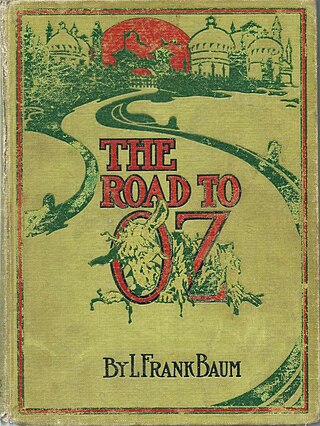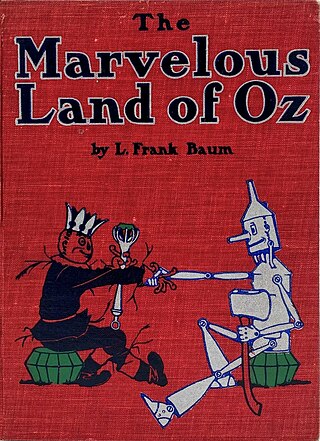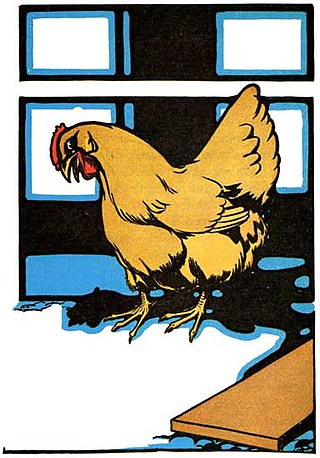
The Patchwork Girl of Oz is the seventh book in L. Frank Baum's Oz series. Characters include the Woozy, Ojo "the Unlucky", Unc Nunkie, Dr. Pipt, Scraps, and others. The novel was first published on July 1, 1913, with illustrations by John R. Neill. In 1914, Baum adapted the book to film through his Oz Film Manufacturing Company. The book was followed by Tik-Tok of Oz (1914).

The Road to Oz is the fifth book in L. Frank Baum's Oz series. It was originally published on July 10, 1909 and documents the adventures of Dorothy Gale's fourth visit to the Land of Oz. It was followed by The Emerald City of Oz (1910).

The Marvelous Land of Oz: Being an Account of the Further Adventures of the Scarecrow and the Tin Woodman, commonly shortened to The Land of Oz, published in July 1904, is the second book in L. Frank Baum's Oz series, and the sequel to The Wonderful Wizard of Oz (1900). This and the following 34 books in the series were illustrated by John R. Neill. It was followed by Ozma of Oz (1907).

Ozma of Oz, published on July 30, 1907, was the third book of L. Frank Baum's Oz series. It was the first in which Baum was clearly intending a series of Oz books. It was followed by Dorothy and the Wizard in Oz (1908).

Tik-Tok of Oz is the eighth book in the Oz series written by L. Frank Baum, published on June 19, 1914. The book has little to do with Tik-Tok and is primarily the quest of the Shaggy Man to rescue his brother, and his resulting conflict with the Nome King. The book was based on Baum's play The Tik-Tok Man of Oz, which was produced in Los Angeles in spring 1913. It was followed by The Scarecrow of Oz (1915).

The Lost Princess of Oz is the eleventh book in the Oz series written by L. Frank Baum. Published on June 5, 1917, it begins with the disappearance of Princess Ozma, the ruler of Oz and covers Dorothy and the Wizard's efforts to find her. The introduction to the novel states that its inspiration was a letter a young girl had written to Baum: "I suppose if Ozma ever got hurt or losted, everybody would be sorry." It was followed by The Tin Woodman of Oz (1918).

Princess Ozma is a fictional character from the Land of Oz, created by American author L. Frank Baum. She appears for the first time in the second Oz book, The Marvelous Land of Oz (1904), and in every Oz book thereafter.

The Land of Oz is a magical country introduced in the 1900 children's novel The Wonderful Wizard of Oz written by L. Frank Baum and illustrated by W. W. Denslow.

The Deadly Desert is the magical desert in Nonestica that completely surrounds the fictional Land of Oz, which cuts it off from the rest of the world.

Tik-Tok is a fictional "mechanical man" from the Oz books by American author L. Frank Baum. He has been termed "the prototype robot", and is widely considered to be one of the first robots to appear in modern literature, though the term "Robot" was not used until the 1920s, in the play R.U.R.

The Scarecrow is a character in the fictional Land of Oz created by American author L. Frank Baum and illustrator W.W. Denslow. In his first appearance, the Scarecrow reveals that he lacks a brain and desires above all else to have one. In reality, he is only two days old and merely naïve. Throughout the course of the novel, he proves to have the brains he seeks and is later recognized as "the wisest man in all of Oz," although he continues to credit the Wizard for them. He is, however, wise enough to know his own limitations and all too happy to hand the rulership of Oz to Princess Ozma and become one of her trusted advisors, though he typically spends more time having fun than advising.

The Nome King is a fictional character created by American author L. Frank Baum. He is introduced in Baum's third Oz book Ozma of Oz (1907). He also appears in many of the continuing sequel Oz novels also written by Baum. Although the character of the Wicked Witch of the West is the most notable and famous Oz villain, it is actually the Nome King who is the most frequent antagonist in the book series.

Billina is a fictional character in the classic children's series of Oz books by American author L. Frank Baum. She is introduced in Ozma of Oz (1907).

The Magical Mimics in Oz (1946) is the thirty-seventh book in the Oz series created by L. Frank Baum and his successors, and the first written by Jack Snow. It was illustrated by Frank G. Kramer. The novel was followed by The Shaggy Man of Oz (1949). The novel entered the public domain in the United States, when its copyright was not renewed as required.

The Wonderful Wizard of Oz, known in Japan as Ozu no Mahōtsukai (オズの魔法使い), is a Japanese anime television series adaptation based on four of the original early 20th century Oz books by L. Frank Baum. In Japan, the series aired on TV Tokyo from 1986 to 1987. It consists of 52 episodes, which explain other parts of the Oz stories, including the events that happened after Dorothy returned home.
The Soldier with the Green Whiskers is a character from the fictional Land of Oz who appears in the classic children's series of Oz books by American author L. Frank Baum and his successors. He is introduced in The Wonderful Wizard of Oz (1900). His name is Omby Amby, but this was so obliquely stated that he also became known briefly as Wantowin Battles.

The Land of Ev is a fictional country in the Oz books of L. Frank Baum and his successors. The country was first visited in Baum's third Oz novel, 1907's Ozma of Oz, and was the first of Baum's countries that surround the Land of Oz. This book introduced the Nome King, a recurring villain who lives underground beneath the Land of Ev.

Queen Ann in Oz is a 1993 children's novel written by Karyl Carlson and Eric Gjovaag, and illustrated by William Campbell and Irwin Terry. The book is an entry in the large and growing literature in the Oz series, begun by L. Frank Baum and continued by many successors.

The Tik-Tok Man of Oz is a musical play with book and lyrics by L. Frank Baum and music by Louis F. Gottschalk that opened at the Majestic Theatre in Los Angeles, California on March 31, 1913. It is loosely inspired by Baum's book Ozma of Oz (1907), incorporates much of the material from Baum's book The Road to Oz (1909), and was the basis for his 1914 novel, Tik-Tok of Oz. It was promoted as "A Companion Play to The Wizard of Oz" and directed by Frank M. Stammers. The play is known from its advertising and published music, but survives only in earlier manuscript.















